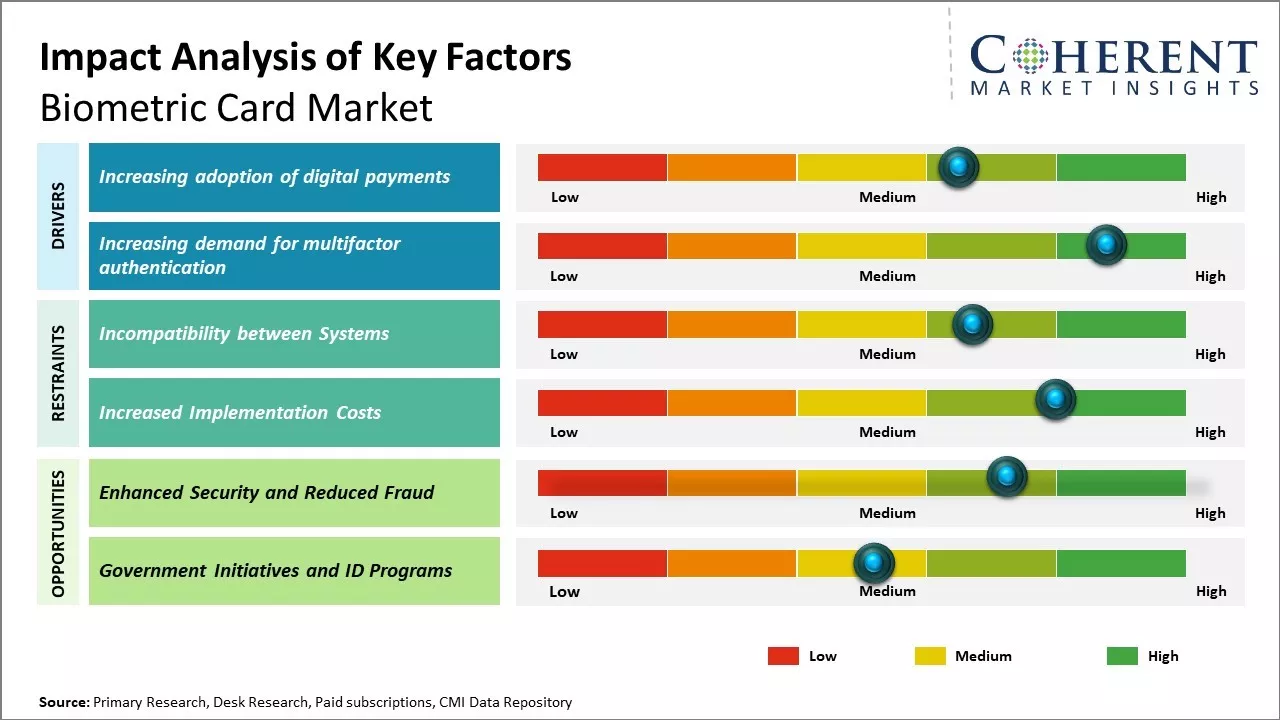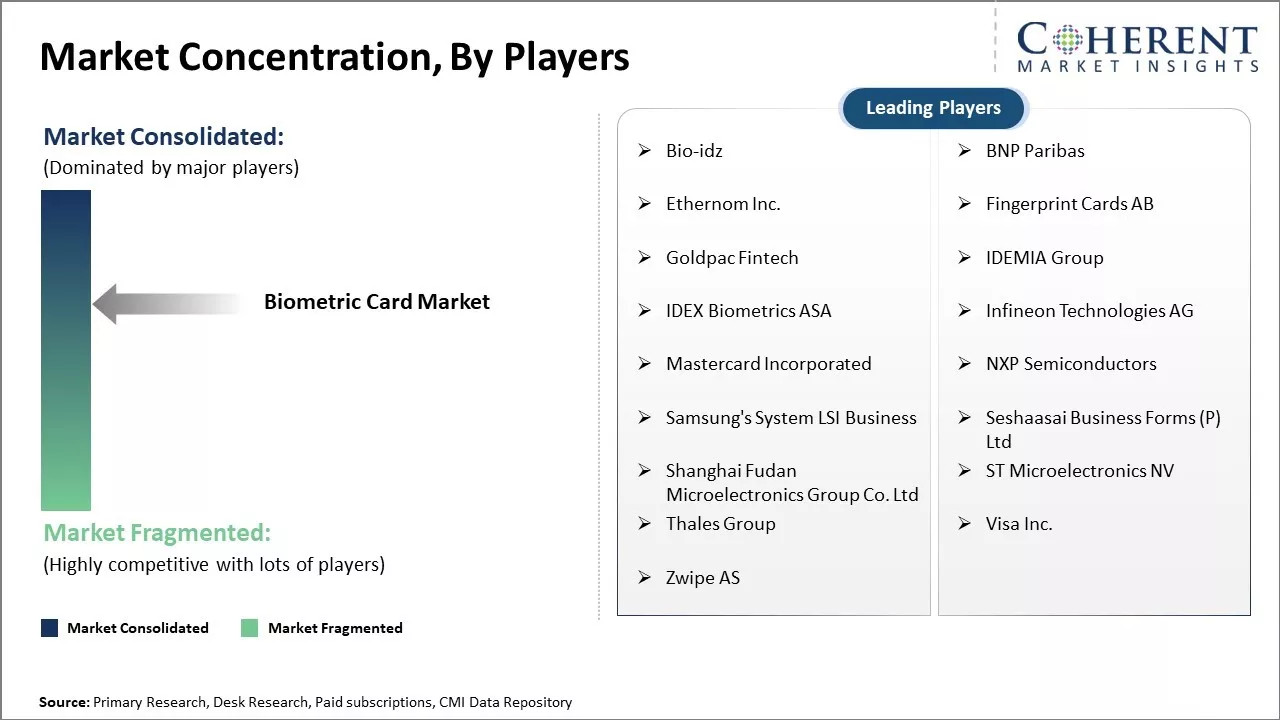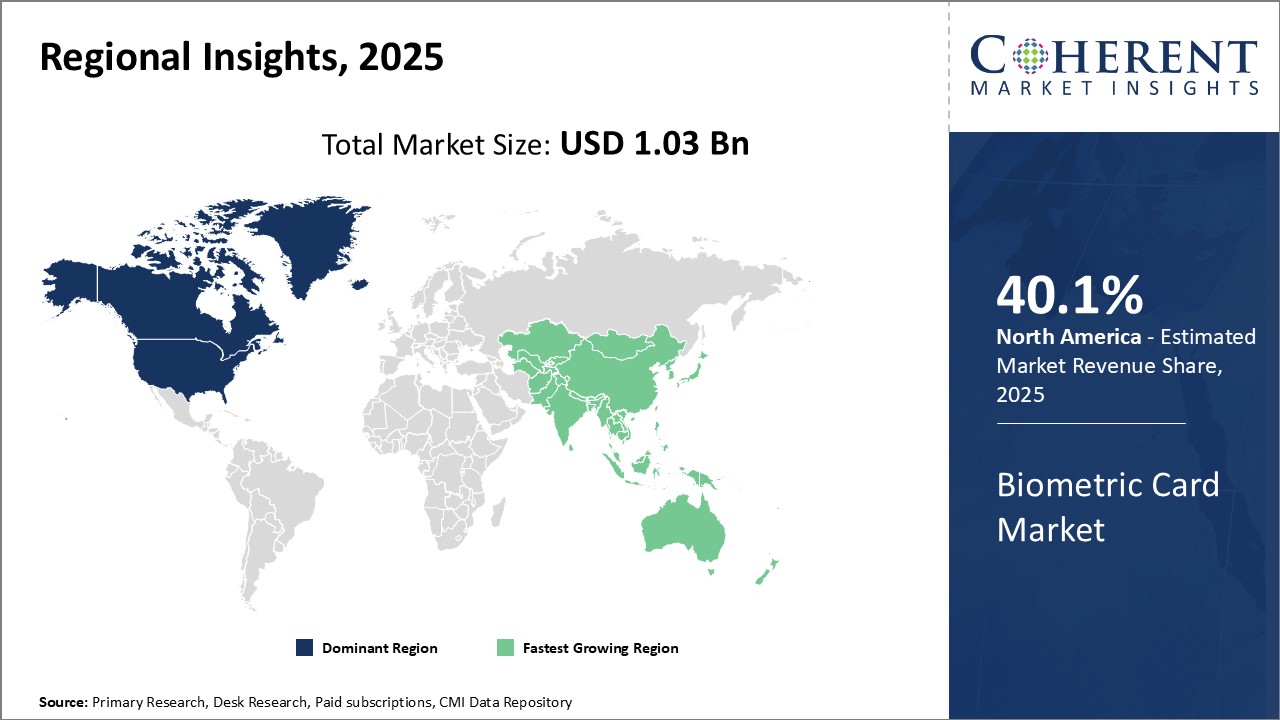The Biometric Card Market size is estimated to be valued at USD 1.03 Bn in 2025 and is expected to reach USD 63.12 Bn by 2032, exhibiting a compound annual growth rate (CAGR) of 80.1% from 2025 to 2032. Increasing demand for secure and reliable identification solutions is driving the growth of the biometric card market. Biometric cards offer two-factor authentication by verifying fingerprints, face, iris, or voice along with security chips. This provides robust security for identification and access to buildings, computer networks, and IT systems.

To learn more about this report, Download Free Sample
The Biometric Card Market Forecast is witnessing high demand from government organizations as biometric cards help in identifying individuals easily and securely. Governments across countries are undertaking digital identity programs and issuing biometric enabled ID cards and passports to citizens. With growing security breaches and increasing instances of document fraud, organizations across industries are adopting biometric cards to authenticate employees and customers, which is further propelling the demand for biometric cards.
|
Event |
Description and Impact |
|
Increasing adoption of biometric technology in financial services |
|
|
Advancements in biometric sensor technology |
|
|
Government initiatives promoting digital identity and financial inclusion |
|
Uncover macros and micros vetted on 75+ parameters: Get instant access to report

To learn more about this report, Download Free Sample
As financial fraud and digital criminal activities become more sophisticated, the need for robust authentication solutions goes beyond simple passwords and PINs. Traditional methods are vulnerable to hacking techniques like phishing, keylogging, and brute force attacks. Criminals develop elaborate schemes to trick users into revealing login credentials or circumvent security measures entirely. This has led to significant financial losses and reputational damage for both individuals and organizations.
In response to these evolving security threats, the biometric card market is experiencing a surge in demand for multi-factor authentication (MFA).
For instance, in May 2022, IDEX and Verisoft collaborated to bring biometric card solutions to the market at reduced prices for issuers and personalization bureaus, enhancing their position in the ecosystem. IDEX expressed enthusiasm about partnering with Verisoft to deliver a comprehensive and agile approach to biometric solution standards, ensuring seamless customer payment experiences.
Biometric cards are expected to see greater adoption as digital payments continue to grow in popularity globally. Over the past decade, there has been a significant shift away from cash payments towards contactless payments using cards, mobile wallets, and other digital means. This trend was further accelerated as consumers sought safer payment options that minimize physical contact.
The growing market for contactless payments and rise of new technologies like mobile wallets have compelled retailers to upgrade their point-of-sale systems as well. Modern payment terminals now support tap-and-pay along with card authentication modes beyond chip-and-PIN. This interoperable infrastructure allows biometric cards to be accepted across merchants smoothy. Major banking institutions believe biometric verification presents a logical next step in the evolution of secure and seamless digital transactions. Wider distribution of biometric payment cards depends on overcoming technology challenges and gaining user confidence in handling biometric data securely. But with digital becoming the default choice for most consumers, biometric cards are well-positioned for significant pick up in coming years.
For instance, Fingerprint Cards AB a biometrics company, predicts that by 2026, approximately 6 billion payment devices will be shipped annually, with nearly all of them being contactless. Additionally, the company estimates the potential Total Addressable Market (TAM) for biometric sensor modules and software in the payment sector to be about 3 billion units per year.
Biometric cards leverage a variety of technologies to verify user identity, including fingerprint scanners, iris scanners, and facial recognition. However, a major hurdle to widespread adoption is the current lack of interoperability between these systems. Imagine a situation where a bank issues a credit card equipped with a fingerprint scanner, but ATMs or retail point-of-sale systems might only have readers compatible with facial recognition.
Biometric authentication adds a powerful layer of security compared to traditional methods like PINs or passwords. Fingerprint, iris scan, or facial recognition verification significantly reduce the risk of identity theft, financial fraud, and security breaches. This fosters trust in digital transactions for both consumers and businesses, leading to wider adoption of biometric cards.
The payments application segment is estimated to hold the highest Biometric Card Market Demand share of 64.6% in 2025, owing to the rising demand for contactless and digital payment methods. As consumers increasingly adopt cashless payment modes for convenience and safety, biometric verification provides strengthened security for financial transactions over traditional PIN or signature-based cards. The integration of fingerprint or facial recognition technology allows cardholders to authenticate transactions with a simple touch or scan, removing the need to enter passcodes repeatedly.
This enhanced user experience streamlines the payments process, encouraging greater usage of cards for small ticket purchases that were previously cash-only. Retailers are also incentivized to upgrade their point-of-sale systems to accept biometric cards, knowing it will increase spend volumes per customer via frictionless checkout. With secure biometrics replacing less reliable security layers like CVC codes, merchants face reduced chargeback fraud from online payments as well.
As digital wallets and peer-to-peer funds transfer see rising adoption, the ability to access account balances and make transfers with biometric verification on a single card form factor is driving demand. Younger consumers especially value this kind of convenience and speed over traditional payment methods. Cybercriminals' increasing exploitation of stolen financial data has also boosted end-user confidence in biometric authentication technology, helping to accelerate the shift away from signature-based cards in the payments segment.
The BFSI industry vertical has captured the highest Biometric Card Market Share of 51.78% in 2025. Within this segment, private financial institutions and banks have a pressing need to securely manage large employee bases and streamline internal processes with biometric identification solutions. Integrating employee authentication via fingerprint onto an existing staff ID card removes vulnerabilities from passwords or token-based systems.
Staff can be verified for building entry, accessing sensitive databases, or authorizing financial transactions in a seamless, contactless manner. This enhances both convenience and security versus carrying separate physical and electronic IDs. Biometric cards also enable new remote working policies to be implemented safely, with employees securely logging into digital systems from any location. Overall operational efficiencies are realized through a single credential performing multiple identification and access control functions.
As the BFSI industry continues broad-based digital transformation, security concerns over identity theft and fraud are paramount. Biometric cards address these issues through reliable one-to-one user verification. Large banks see this as a worthwhile investment that streamlines the user experience for personnel while strengthening resilience against the growing sophistication of cyberthreats. The ability to future-proof identification infrastructure with upgradeable biometric cards is another factor driving their adoption in this segment.

To learn more about this report, Download Free Sample
in 2025, North America will dominate the Biometric Card Market value, capturing a sizable portion of 40.1%. The region’s supremacy is due to the presence of some of the most important biometric card manufacturers, such as IDEMIA, Idex Biometrics, and Thales Group. These corporations have located North America as a primary center for the invention and crafting of biometrics card technology. The ongoing fierce competition increases R&D investments, paving the way toward the development of more secure card formats.
Demand wise, the North American region has led the adoption of biometric identity verification for the protection of critical infrastructure and commercial applications. High use of biometric cards for physical access control in sensitive and high-security areas such as airports, government and military facilities are significantly helping the growth of the market. Moreover, biometric debit and credit cards are now being issued by financial institutions, making transactions more secure and easier for customers, which adds to the growth of the market.
Asia Pacific region is projected to experience the fastest growth in the Biometric Cards Market Trends in 2025. Countries like India, China, and South Korea are actively upgrading their ID systems from conventional IDs to secure digital formats like biometric smart cards. This shift is projected to greatly increase the demand for biometric cards.
In addition, the region has increased demand from the travel and tourism sectors, with plans in various countries to implement biometric passports and visa cards for enhanced identification of foreigners at entry points. There is also younger working class that is rapidly growing, along with increasing investments in biometric fintech solutions which drives the need for biometric authentication. Financial institutions are now adopting advanced biometric technologies for contactless payment services, improving customer security and convenience. With its large population and emerging economies, Asia Pacific presents significant opportunities for biometric card manufacturers, making the region a prospective leader in the global biometric card market.
China is predicted to dominate the biometric card market in the Asia Pacific region. China is the world’s manufacturing powerhouse and is investing in modernizing its identity systems to more secure digital formats. There is a market need for biometric cards because the country is implementing biometric solutions at all government services, financial institutions, and large-scale public security works.
Potential growth of biometric cards is noted in India due to the industrialization of the country along with government initiatives for a digitized identity verification system. The country is gradually implementing biometric solutions in banking, healthcare, and other public services which is driving the market. Given the growing need for security and convenience, India will experience a rise in biometric cards in the near future
Expansion in the biometric card market in South Korea is being driven by the country’s advanced technological infrastructure and innovation focus in finance, telecommunications, as well as healthcare. The region is one of the leading adopters of modern biometric authentication systems, particularly in banking and public service and will continue to flourish in biometric card usage markedly adding to the Asia Pacific biometric card market. Enhanced security as well as seamless user experience in South Korea are other factors which support the growth of biometric cards in the country and the region as a whole.
The consumer electronics, automotive, and healthcare industries have positioned Japan as a technological leader which greatly aids in the development of the biometric card market. The shift of the country towards secure digital identity solutions drive the acceptance of biometric cards. There’s high expectation of growth in the adoption of these cards in Japan due to continuous innovation in biometric security which impacts sensitive and high efficiency demanding sectors.
| Report Coverage | Details | ||
|---|---|---|---|
| Base Year: | 2024 | Market Size in 2025: | USD 1.03 Bn |
| Historical Data for: | 2020 To 2024 | Forecast Period: | 2025 To 2032 |
| Forecast Period 2025 to 2032 CAGR: | 80.1% | 2032 Value Projection: | USD 63.12 Bn |
| Geographies covered: |
|
||
| Segments covered: |
|
||
| Companies covered: |
Bio-idz, BNP Paribas, Ethernom Inc., Fingerprint Cards AB, Goldpac Fintech, IDEMIA Group, IDEX Biometrics ASA, Infineon Technologies AG, Mastercard Incorporated, NXP Semiconductors, Samsung's System LSI Business, Seshaasai Business Forms (P) Ltd, Shanghai Fudan Microelectronics Group Co. Ltd, ST Microelectronics NV, Thales Group, Visa Inc., and Zwipe AS |
||
| Growth Drivers: |
|
||
| Restraints & Challenges: |
|
||
Uncover macros and micros vetted on 75+ parameters: Get instant access to report
*Definition: The biometric card market involves the research and development, manufacturing, and sale of smart cards that incorporate biometric technology. Biometric cards use fingerprint scanning, facial recognition, iris scanning or other biometric identifiers to authenticate the identity of an individual. These advanced identity cards are used for security applications such as ID management, access control, e-passports, national IDs, driver's licenses and more. The biometric card market has seen significant growth as governments and organizations aim to enhance security through multi-factor authentication.
Share
Share
About Author
Monica Shevgan has 9+ years of experience in market research and business consulting driving client-centric product delivery of the Information and Communication Technology (ICT) team, enhancing client experiences, and shaping business strategy for optimal outcomes. Passionate about client success.
Missing comfort of reading report in your local language? Find your preferred language :
Transform your Strategy with Exclusive Trending Reports :
Frequently Asked Questions
Joining thousands of companies around the world committed to making the Excellent Business Solutions.
View All Our Clients